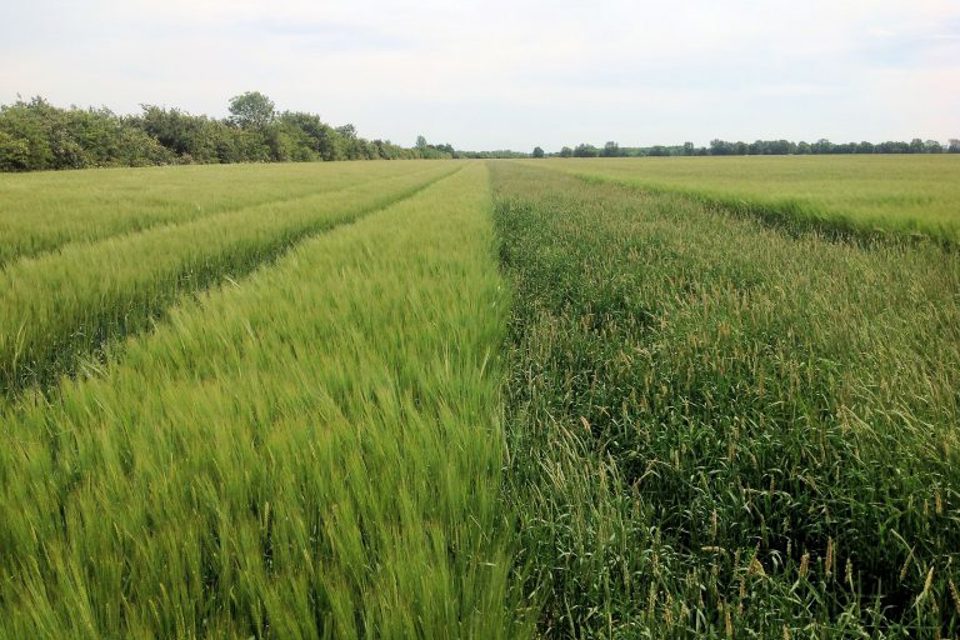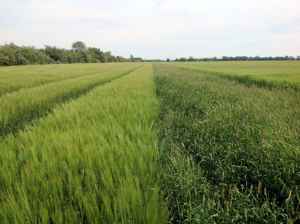
Spring barley helps battle black-grass in Cambridgeshire
Case Study - 19.07.17
Cambridgeshire grower, Edward Davison, is happy to sacrifice margins to get on top of some of the country’s worst black-grass. But thanks to a specialist spring barley suited to his heavy chalky boulder clay, he’s hardly had to.
In fact, in 2015 the 120ha of Explorer grown at New Farm, Elsworth, delivered almost the same margin as the first wheat on which the farm’s 600 ha arable rotation is based. At the same time, it slashed the black-grass population.
Edward says he had always rated barley as “little more than a weed itself”, but research from Stow Longer about its impact on black-grass persuaded him to give it a go.
“We discovered our black-grass was Triple R resistant more than 10 years ago,” says Edward, who grew the barley on a Budweiser contract with Agrii, Glencore and Crisp Malting.
“We have it sampled every year and never have a sample coming back at less than RRR. We haven’t bothered using Atlantis for four or five years now, and we’d been spending heavily on residuals to bolster wheat performance.
“Despite doing everything we could in our five-block rape/ wheat/ rape/ wheat/ wheat regime though, escalating weed levels and declining returns persuaded us to throw everything up in the air in 2015 and introduce at least one spring crop into the rotation.
“Apart from anything else, it’s sobering to see the combine yield meter running along nicely at 10-11 t/ha in the wheat, only to plummet to 5t/ha or less whenever you hit a bad black-grass patch. Something clearly had to change,” says Edward.

Edward Davison
Stow Longa research confirms spring barley value
Edward says his decision to try growing spring barley was confirmed when he discovered Explorer and the work Colin Lloyd and his Agrii research team were doing with bad black-grass at Stow Longa.
“A high yielding, relatively early maturing variety, that can be sown late into March on heavy ground, and earn an extra malting premium for a higher N sample, was an attractive proposition,” he says. “But the clincher for us was the variety’s superior weed-smothering ability.”
This ability was confirmed when Edward’s first Explorer crop resulted in an almost six-fold reduction in the black-grass population, compared to a strip that was left unsown in the same field.
Agrii monitoring revealed a black-grass count of 120 ears / m2 in the Explorer, but more than 700/ m2 in the strip. The ears were also well down in the crop, much smaller and with seed of suspect viability.
As soon as the crop was harvested in mid-August, the black-grass beneath it took off like a rocket, highlighting the extent to which it had been suppressed by the barley and giving the farm the bonus of a massive early glyphosate weed kill in the stubble.
In addition, the Explorer averaged 10.4 t/ha at 1.72% N from 150 kg/ha of nitrogen to deliver a gross margin of almost £950/ha. This was only just below New Farm’s average first wheat margin, despite a grain N just too low to qualify for the £5/t additional Budweiser premium.
Better targeted fertilisation
Achieving success with barley yields, while also reducing black-grass polpulations, was a careful balancing act with nitrogen application, says Tom Land, Agrii fertiliser technical manager, who planned the nutrition and monitored the crop.
“It was a classic case of nitrogen dilution,” he says. “We targeted a 9t/ha crop with 50 kg/ha of N in the seedbed before drilling, another 50 kg/ha as soon as we could see the rows, and a final 50 kg/ha at GS21 in late April.
“However, to blow our yield assumptions out of the water, the crop took advantage of fantastic seedbed conditions, a complete lack of compaction thanks to regular rotational subsoiling, sufficient soil moisture, and a long, cool summer.
“If it hadn’t yielded as well, we’d easily have made the Budweiser spec to earn the extra premium. But with the full Propino premium the 10.4 t/ha crop earned more than 9t/ha would have done at the higher premium level. So we certainly weren’t disappointed.
“Based on this experience we upped the nitrogen rate to 170 kg/ha – all the extra in the final split – in the Explorer this past season. We also fine-tuned the micro-nutrition based on three separate crop tissue tests and research from AgriiFocus Technology Centres,” says Tom.
Edward adds; “Other than these tweaks, we feel we’ve got the agronomy pretty much spot-on. Despite the noticeably less good growing conditions, our 2016 crop came in at a very commendable 9.4 t/ha with nitrogens comfortably within the Budweiser specification at 1.90% to 1.99%.”

New drill will help delay Autumn drilling
The next step will be using an ultra-flexible Sky Easydrill to drill the crop, says Edward.
“Its extra capacity will be really valuable in cutting wheat drilling days from eight to six, allowing us to delay Autumn drilling as late as we dare for the best black-grass control.
“The fact that it moves so little soil as a no-till or min-till drill, will be crucial – for both Autumn and Spring drilling – as will its ability to drill into cover crops should we go down this route.
“The spring barley will also profit from seedbed fertiliser placed precisely with the seed rather than incorporated ahead of sowing.
“After our second spring barley in a row we had planned to put the ground into oilseed rape. But with conditions so dry and such a high flea beetle threat, we’ve opted for a third crop of Explorer.
“We’ll be replacing all our planned OSR acreage with the spring barley, increasing our 2017 crop to 280 ha. In addition to improving margins, this should strike a big blow against the black-grass.
More flexible rotational approach
From now on Edward plan to take a more flexible approach to his rotation.
“We intend to have at least one year of spring barley in every field, with a longer spring break wherever necessary, “ he says. “So, rather than having a rigid regime, my agronomist and I will be sitting down every summer to assess the situation field-by0field and plan accordingly.
“This is driving a coach and horses through the convenience of our original block-cropping approach. But I see it as essential if we are to secure the consistent 11-12 t/ha wheat crops we want.
“Although we know we can get these already, our challenge is to it reliably across the whole farm – and this means we simply have to deal with the black-grass affected crops that pull down our average so substantially.”
Join Our Community

Agrii X
We love engaging with clients and partners. Give us a follow and let's share stories for the community.

Agrii Instagram
A picture paints a thousand words. Follow us on Instagram to see what we are up to.

Agrii Facebook
Follow us on the worlds biggest social media site for the latest news and events straight to your feed.

Agrii LinkedIn
If you are all about the business, connect with us on LinkedIn to build your network
Stay In Touch

Journal Sign-Up
Receive email updates on topical news and information from around Agrii and UK Farming.

Listen To Our Podcasts
Listen to the Tramlines Podcast. Fortnightly chat about agriculture and trials with your host Tony Smith.

Agrii Insights
Read essential agri intelligence for profitable farming.

Find an Event
Join us for our upcoming events and tours.



